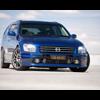Brake Rotor (disc) Installation
Announcements
-
Similar Content
-
Latest Posts
-
In the context of cam 'upgrader' I mean generally people who upgrade headers/cams - not my specific change. I mean it makes sense that if I had a bigger cam, I may get more false lean readings. So if I went smaller, I'd get less false lean readings. To a point where perhaps stock.. I'd have no false lean readings, according to the ECU. But I'm way richer than stock. My bigger than normal cam in the past also was giving false rich leanings. It's rather odd and doesn't add up or pass the pub test. Realistically what I want is the narrowbands to effectively work as closed loop fuel control and keep my AFR around 14.7 on light sections of the map. Which is of course the purpose of narrowband CL fuel control. So if I can change the switch points so the NB's target 14.7 (as read by my WB) then this should be fine. Haven't actually tested to see what the changed switchpoints actually result in - car needs to be in a position it can idle for awhile to do that. I suspect it will be a troublesome 15 min drive home with lots of stalling and way too rich/lean transient nightmare bucking away for that first drive at 2am or whevener it ends up being. Hopefully it's all tune-able. Realistically it should be. This is a very mild cam.
-
Messing with narrowband switchovers is a terrible bandaid. I don't want to think about it. You are a cam "upgrader" only in concept. As you said, your new cam is actually smaller, so it's technically a downgrade. OK, likely a very small downgrade, but nevertheless. But the big thing that will be the most likely suspect is the change of the advance angle. That change could be equivalent to a substantial decrease in cam lobe duration. I haven't gone to the effort of trying to think about what your change would actually cause. But until someone (you, me (unlikely), Matt, someone else) does so and comes to a conclusion about the effect, it remains a possibility that that is the change that is causing what you're seeing.
-
The previous switchover point was 501mv. The stock value is like ~360. They now were idling at about ~880. The thing is, most people get a false lean condition. I am getting false rich conditions. This isn't a quirk of terminology, most cam upgraders get awful fuel economy because the O2's read false lean and add fuel - Mine are attempting to aggressively subtract fuel.
-
So... the whole idea was to upgrade the power of the motor from stock. The motor I bought with the gearbox had 'some' stuff done to it in the past, but it wasn't as well thought out/what I had wanted to do. The stock heads typically are a big restriction on LS's and need porting to unlock quite a lot of power. You can then go a bit silly with aftermarket castings to get more, aftermarket intake manifolds for a little more, and then porting those for more. <- We are here. Nobody in Australia really goes down this path (for some reason). It might* make 3kw or something more than doing things the tried and true path for 10X the cost. So that's probably why - I wouldn't even recommend it to people, the money was and is likely better spent on just CNC'ing the stock heads and putting a 6.3L stroker kit in. I didn't want to go down the 'normal' path and then think: But if I'd just done a bit more - I could have had a slightly better result. I assumed the heads were running out of flow and it always annoyed me - Turns out the previous installer advanced the cam 6 degrees so this is likely why it was coming on earlier and running out of puff earlier than advertised. The body panels were just lack of planning/no information on this anywhere on the internet and the fact they came out different was annoying. From test fitting the guard it appears I could have gotten away with GTR guards only, but I got the bonnet and raisers and everything else as well for a pretty decent package deal.
-







Recommended Posts
Create an account or sign in to comment
You need to be a member in order to leave a comment
Create an account
Sign up for a new account in our community. It's easy!
Register a new accountSign in
Already have an account? Sign in here.
Sign In Now